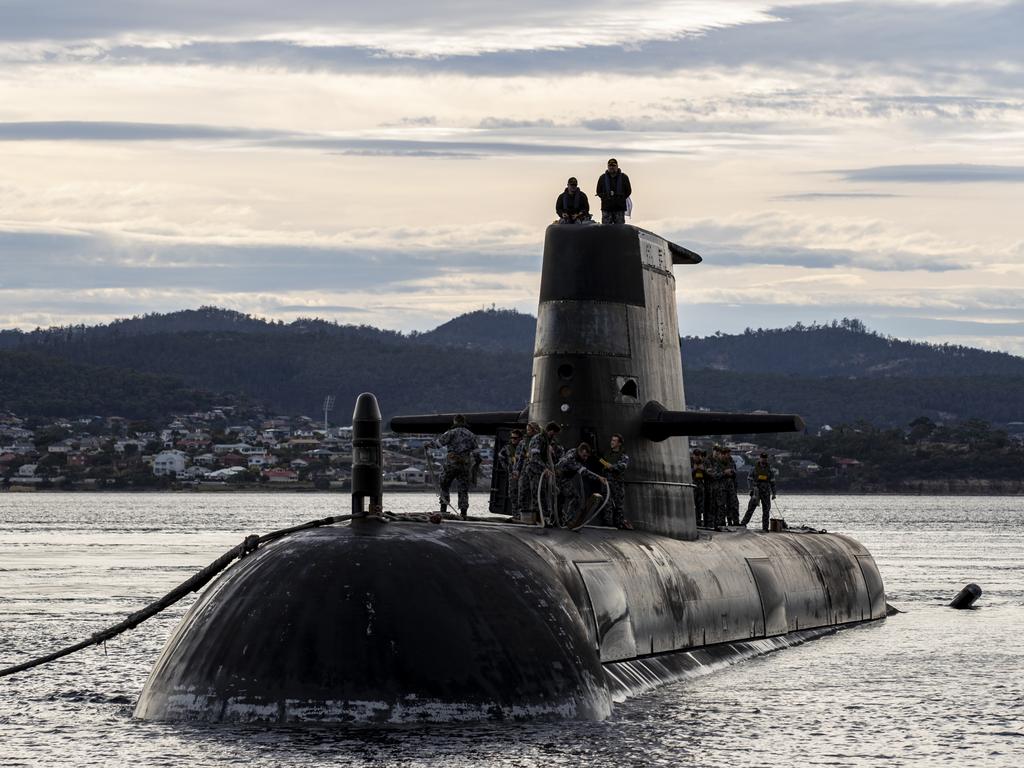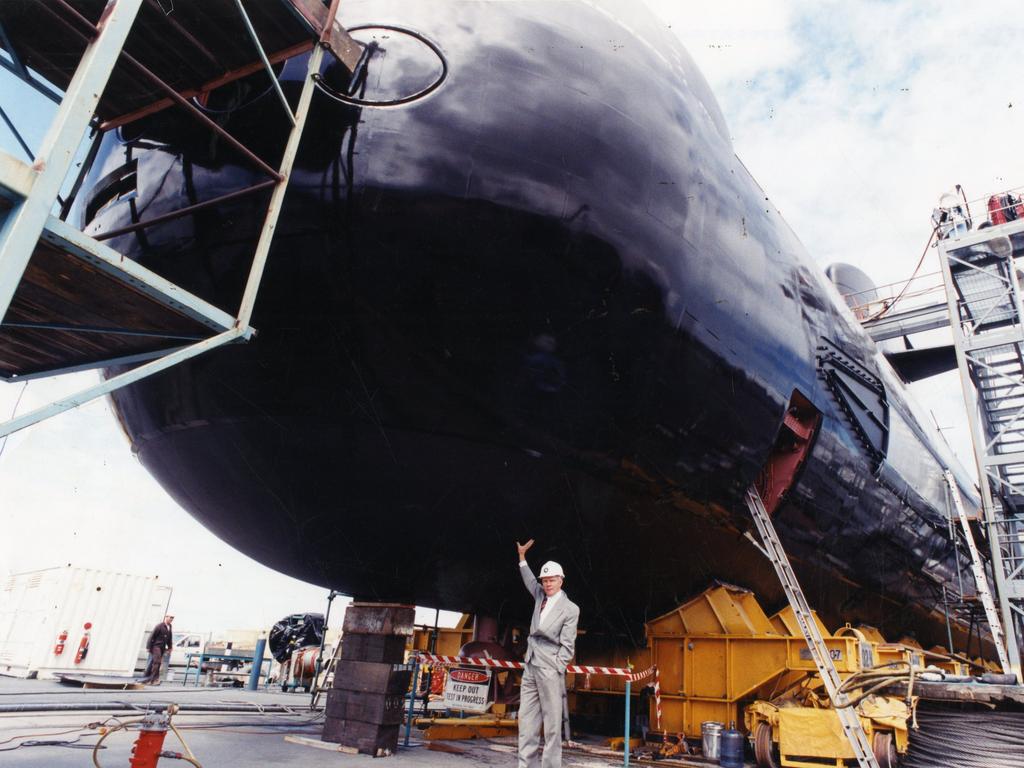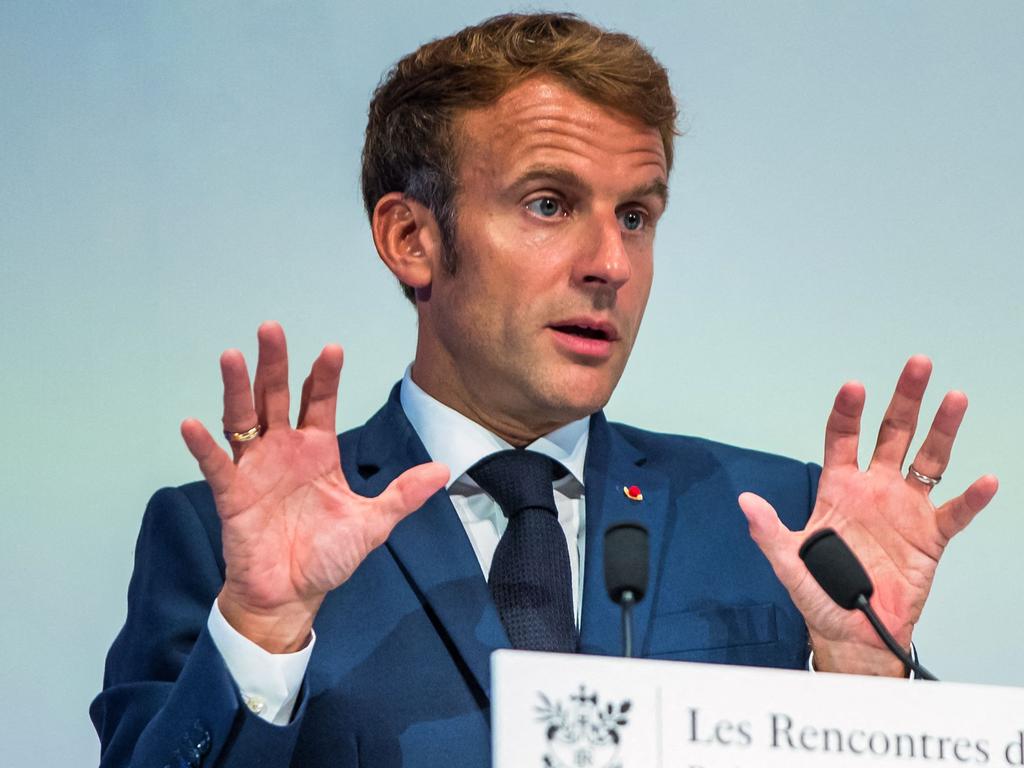In defence of Australian shipbuilding
To understand how much confusion still surrounds the government’s shift to nuclear-powered submarines, look no further than the Defence Department website. It’s no joke.

To understand how much confusion still surrounds the government’s historic shift to acquire nuclear-powered submarines, one needs to look no further than the Defence Department website.
There you will find – in a scene worthy of the satirical sitcom Yes, Minister – a single page with two conflicting visions for the future of Australia’s defence and shipbuilding industry.
The first part touts the “important announcement on submarines” of September 16, declaring the French project to build 12 boats will be scrapped for the “acquisition” of eight nuclear-powered submarines.
The second part of the page speaks glowingly about a $180bn defence industry policy which has now been all but torpedoed by the nuclear submarine plan.
The 2017 policy, called the National Naval Shipbuilding Enterprise, aimed to produce a “continuous” rollout of warships and submarines in Adelaide over the decades ahead.
“The enterprise is about more than building ships, submarines and shipyards – it will establish a long-term sustainable Australian shipbuilding and sustainment capability that will generate industry growth and develop secure Australian jobs for the future,” the Defence web page states.
But no one – possibly not even the Morrison government and its PR spinners – seriously believes that Australia’s defence and naval shipbuilding industry will ever be the same again as a result of the AUKUS pact and the associated plan to acquire nuclear-powered submarines.
At best, the industry in Australia, which employs about 25,000 people, many of whom are directly or indirectly involved in naval shipbuilding projects, will slowly atrophy because even under the most optimistic scenario, the first of the nuclear-powered submarines will not be completed in Adelaide until about 2040, six years after the first French boat was due.
At worst, the new submarines may not be built in Adelaide at all. Given the strategic urgency posed by the rise of China, the ageing of the current Collins-class submarines and the enormous cost and technical challenges of building nuclear-powered submarines in Australia, the government may simply choose to lease or buy ready-made subs from the US or Britain. If so, Australia would no longer be a builder of submarines, leaving the project to build nine new Hunter-class frigates as the last major hurrah for the country’s naval shipbuilding industry.
Neither of these scenarios bodes well for Australian industry, which is why it is now demanding answers from the government about whether Canberra is still committed not just to the prosperity of a local shipbuilding industry, but to its very existence.
“We have been told nothing concrete by the government,” says Brent Clark, who heads the Australian Industry and Defence Network, which represents more than 1000 small and medium sized defence-related companies. “I think the issue is that they don’t know yet themselves.”
Clark accepts that the Morrison government has the right to change its plans on submarines but he wants assurances the local shipbuilding industry will not become collateral damage.
“We understand that the strategic circumstances we find ourselves in have degenerated – blind Freddy can see that,” he tells Inquirer. “But our greatest fear is that a lot of people seem to be saying ‘let’s buy the submarines from overseas’ and not worry about local industry.
“We don’t want this (nuclear submarine plan) to become an export program for American and British companies at the expense of Australian companies.”
The Australian Shipbuilding Federation of Unions also doubts the government’s commitment to local shipbuilding after cancelling the French project.
“We’re calling on the government to stick to the priority it set out in creating a sovereign industrial capability in Australia and not just exporting opportunities to the UK and US industry,” says Australian Manufacturing Workers Union assistant national secretary Glenn Thompson.
The government has given itself 18 months to assess how best to move forward with the plan to build a fleet of nuclear-powered submarines with the help of the US and the UK. The hope is that after 18 months the government will have answers to the key questions of how it will acquire and sustain at least eight nuclear-powered boats, and what the ramifications are for local industry.

So far, all Scott Morrison has said is that they will be built in Adelaide but he has offered no further details.
In response to questions from Inquirer, defence industry minister Melissa Price denies that the government is abandoning its naval shipbuilding plan and claims the new AUKUS pact will eventually provide “a world of new opportunities for Australia’s defence industry”.
“We will need an industry established around our nuclear-powered submarines to support and maintain them,” she says.
“I wanted to reassure those businesses that I have their backs and that supporting small business is my top priority.”
The great mystery is whether the AUKUS agreement and the long timelines for the nuclear submarine project are leading the government to abandon its core philosophy on naval shipbuilding. Is it now willing to sacrifice Australian industry and jobs by building fewer or no submarines in Adelaide in favour of the potentially cheaper and quicker purchase of nuclear-powered subs from established shipyards in the US and the UK?
When asked to confirm whether all the nuclear-powered submarines would be built in Adelaide, Price was non-committal, saying only that “we intend” to build the subs in Adelaide but that “our priority is to have a superior submarine capability for our region. That is why we will work with the US and UK over the next 18 months to determine how we best acquire nuclear-powered submarines”.
Such a potential policy U-turn would have seemed unthinkable only a few years ago when the then prime minister Malcolm Turnbull unveiled his much-touted 2017 National Shipbuilding plan, which promised to protect and foster a permanent and continuous Australian naval shipbuilding industry. The plan was the response to a pattern of repeated failures in naval shipbuilding which saw major projects – from the Collins-class submarines to the Air Warfare Destroyers – suffer from major technical problems, cost blowouts and delays.
A landmark 2015 report by the Rand Corporation estimated that there was a 30 to 40 per cent extra cost of building naval ships in Australia compared with purchasing them off-the-shelf from overseas.

But Rand also said that the government could greatly reduce these extra costs if it rationalised local shipbuilding to ensure that there was a continuity of projects – a “continuous build” – to maintain skills, jobs and knowledge.
It said such a policy would prevent the so-called Valley of Death job and skill losses associated with the previous stop-start naval shipbuilding industry.
The Turnbull shipbuilding plan aimed to create for the first time a continuous build that would span the construction of Australia’s new navy – the recently completed air warfare destroyers, the new offshore patrol vessels, new frigates and the new submarines.
By doing this, the government hoped it would minimise the extra costs of building in Australia while also reaping the reward of fostering local industry, jobs and know-how. It awarded these major projects to Adelaide with a keen eye to shore up its own political fortunes in South Australia’s marginal seats.
But the benefits of the Turnbull plan will now be lost because the continuous cycle of shipbuilding will be broken by the slower start to the nuclear submarine project, assuming it starts at all.
So will the government still be willing to swallow this extra risk to cost and schedule by building the nuclear subs in Adelaide?
Can it afford to do so strategically when it needs faster solutions in the face of a rising China? Or will it look to buy offshore to save time and money, even though that would cost thousands of Australian jobs and may spark a political backlash in South Australia?
“I do think there is a bit of recalibration going on in the government,” says Marcus Hellyer, senior analyst with the Australian Strategic Policy Institute.
“It is unclear whether this is at a policy level or whether they simply decided to go with SSNs (nuclear submarines) and will now work out the messy details as they go along.”
Hellyer says that although the government has recently embraced the idea “if it can be built in Australia, it should be”, there was no guarantee it won’t move to a more economically rationalist position which says that the defence budget and national security are not tools to subsidise a local defence industry.
“Right now the entire shipbuilding program is in disarray with the cancellation of the French Attack submarines and the delays in the frigate project,” he says.
Hellyer believes the best way to sustain the industry now would be to order another major project, such as the building of several more air warfare destroyers to complement the three AWDs that have recently been built.

“You need a big industrial program to generate thousands of new jobs and set the industry up for the nuclear submarine project when it starts,” he says.
AIDN’s Clark says the rise of China makes it more important than even to foster a sovereign naval shipbuilding capability.
“Why in the current strategic circumstance would you not want to create a sovereign domestic industry?” he says. “Otherwise you are putting Australia in a situation where it is forever beholden to the whims of other countries.”
Clark is also seeking answers from the government on what will happen now to those local defence companies which have already taken an estimated $120m hit from the cancellation of the $90bn French submarine contract after investing in new systems, equipment and personnel to win contracts with France’s Naval Group.
He estimates that about 600 contractors had qualified as Naval Group suppliers, including 400 with signed contracts that spent an average of $200,000 each in the hope of securing work with Naval Group.
Clark is not calling for the government to reimburse these companies but says he wants those companies to be given clear priority in future contracts relating to other naval projects, such as the frigates and the construction of the nuclear subs.
“The government has changed strategic direction and that is fair enough, but we would like defence to prioritise those companies moving into the supply chain of the Hunter-class frigates and other maritime projects,” he says.
Price says the government will help those defence companies that signed contracts or invested money into the French submarine project so they can “compete for future work in either the shipbuilding domain or in the wide array of Defence”.
The project to construct 12 French-designed submarines was expected to employ around 6000 people both directly and indirectly.
An even larger workforce will eventually be needed if the government proceeds with its plans to construct nuclear-powered submarines in Adelaide, but this construction project will not begin until more than a decade from now, in or around 2033.
Independent federal senator and former submariner Rex Patrick is more pessimistic about the future of the submarine fleet after the AUKUS decision. He believes the only way to safeguard Australia’s security as well as keep its shipbuilding industry alive is to build more interim conventional submarines in Adelaide – sourced from either Europe or Japan – before the nuclear submarine project begins.
“The submarine building industry is currently in a mess,” Patrick says. “This announcement effectively kills off our submarine capability. It is no longer a valley of death, it is a sloping continental shelf plunging into the abyss.”

Patrick doubts the government wants to build submarines in Australia anymore.
“For all the excitement, I don’t think the government is genuine about building in Adelaide so it will be the end of Australian-built submarines. We will be left with the old Collins-class submarines that will eventually be steel coffins because they will be 40 years old,” he says.
The slow timeline for building nuclear subs means that the government is under acute pressure to ensure that the AUKUS project is not delayed. It will examine the possibility of leasing nuclear-powered submarines from the US or the UK as a stopgap measure.
The temptation will be for the government to plug this potential capability gap by buying at least the first few of the eight nuclear submarines from shipyards in either the US or the UK rather than building them in Adelaide.
If so, then ASPI’s Hellyer believes it could spark an exodus of Australian companies that are currently involved in defence and shipbuilding.
“The Australian defence industry has long memories,” he says of Labor’s defence budget cuts in 2012 which hit the industry hard.
“Some companies may say that it’s not worth it to play in the defence industry space because you are at the whim of just one customer. So when the government changes its priorities it doesn’t matter how good your product is, all that money you have invested is gone.”
Having made the historic decision to acquire nuclear-powered submarines, the Morrison government must now decide whether it’s priorities have changed.
Has AUKUS altered the balance on submarines between costs, schedules, capabilities, jobs, politics, local industry and international alliances?
Canberra must look into the mirror and decide if it still wants a naval shipbuilding industry in Australia – and, if so, at what cost?






To join the conversation, please log in. Don't have an account? Register
Join the conversation, you are commenting as Logout